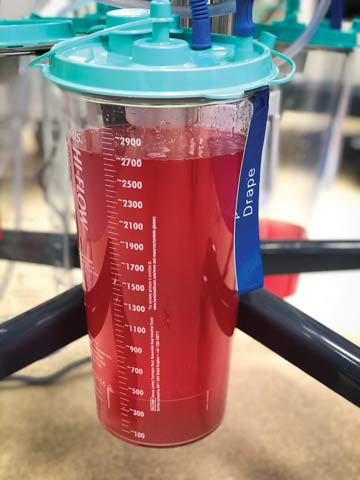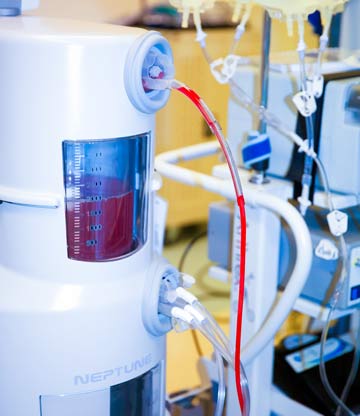There's more than one way to keep OR floors dry when fluid runoff starts to flow. You can sop it up, solidify it or send it directly to the drain. Efficiencies and cost-savings are important factors when you're considering which method is best, but be sure the option you choose also minimizes staff exposure to the potentially infectious fluid.
- Home
- Article
How Should You Manage Fluid Waste?
By: Vangie Dennis
Published: 5/7/2019
You have several options to choose from, but only a few ways to do it safely.
Pouring fluid waste down the hopper is a low-cost solution if the practice is permitted by local laws that regulate the disposal of medical waste in your community. Exposure risks with this method are significant, however. Fluid can splash on the hopper, on the staff member doing the pouring, and on the walls and floors surrounding the sink. That's why you must insist that the staff member who's doing the pouring always wears proper protective equipment: gown, gloves, mask and eyewear.
You also need to be aware of an unseen risk associated with pouring: It creates a plume of aerosolized fluids that staff (the pourer as well as those nearby) can inhale and can also coat equipment and other solid surfaces.
The risks don't end after the contents of the suction canister are poured and flushed. For example, if you don't tightly cap empty reusable or disposable canisters, or if the canisters are cracked, residual fluids can leak out and increase exposure risks for unsuspecting reprocessing and environmental services personnel.
You can collect fluids in disposable canisters, seal the canister lids to contain the fluids and dispose of the canisters in red bag waste. Keep in mind that both OSHA and Department of Transportation regulations require canisters to be placed in secondary packaging that is rigid, closeable, leak-resistant and impervious to moisture. That special packaging can add 10% to 20% to the cost of disposing of infectious waste. For example, the disposal of a wrapped 3-liter canister of fluid can exceed $2.25.

Gelling powders were introduced about 15 years ago to address leaking and spilling risks associated with capping fluid-filled canisters. The powders turn the fluids into a gelatinous-like substance in about 5 to 10 minutes. But you'll find that solidifying fluid waste has the same drawbacks as capping, plus several unique drawbacks of its own. The most obvious is cost. In addition to the costs of the disposable canister, each dose of gelling powder runs $2 or more.
Solidifying is dose-dependent. You must judge the amount of agent needed to adequately gel the amount of fluid in each canister, a process that could lead to overdosing and wasting the gelling agent. But you also need to be concerned about underdosing, which can lead to leaking canisters.
Solidified fluid also adds significant weight to red bag waste — filled containers can weigh between 7 pounds and 35 pounds — of which it costs between 20 cents and 50 cents per pound to dispose.
Compared to manual pouring, capping and solidifying can more than triple the weight of OR infectious waste. That's a significant concern when you consider a typical OR can generate about 2 tons of fluid each month.
One final note about the use of solidifying agents: Suction canisters coming out of the OR can contain large whole blood clots. Most gelling agents that claim treatment of suction canister waste base their efficacy on blood serum testing only, and many of those products are not approved for the treatment of clots.

Closed fluid waste disposal systems essentially remove all risk of fluid exposure and risk of injury from moving filled suction canisters. Mobile collection carts, which are wheeled into ORs where fluid-producing cases are performed, attach directly to collection pouches on the surgical drapes, floor-wicking devices and fluid-retaining mats placed around the sterile field. The large-volume units have enough capacity to handle fluid runoff during multiple cases. When they're filled, a staff member wheels the easy-to-maneuver unit to a dedicated docking station, which automatically suctions the fluid contents directly into the sewer.
After discharge of the infectious liquids into the sanitary sewer, one system automatically cleans and disinfects the inside of the mobile carts with an enzymatic cleaner, surfactants and a U.S. EPA-approved disinfectant. After the cleaning and disinfection process, you can safely open the system, remove the fluid collection reservoirs for reuse and dispose of the system's disposable manifolds as general waste, which helps reduce red bag disposable expenses. The disinfecting cycle also ensures the reservoirs are clean and free of microbial pathogens before you wheel the system back to the next OR.
Wall-mounted disposal systems offer a more affordable option that eliminates risk of exposure to splashing and aerosolized fluid particles. You'll also avoid the added expenses of solidifying gel and disposing of solidified fluid in red bag waste.
Healthcare facilities are the second-leading contributor of waste in the United States, generating 6,600 tons of waste daily and more than 4 billion pounds of waste per year. And the OR is one of the largest producers of waste in healthcare facilities, accounting for 20% to 30% of total waste. Your staff is responsible for the proper handling of fluid waste from the point of origin. You're responsible for ensuring they can do it safely. Integrated waste management systems can limit exposure risks during the collection and disposal of infectious fluid. Adding one or more to your facility will give you peace of mind in knowing you're protecting your staff from harm, and your team will recognize and appreciate the investment you make in their well-being. OSM
.svg?sfvrsn=be606e78_3)
.svg?sfvrsn=56b2f850_5)